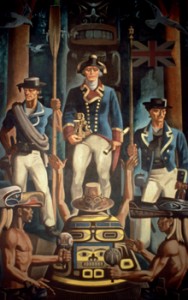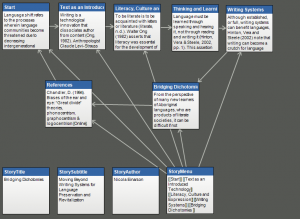Neil Postman’s chapter on “The Judgment of Thamus” from his book Technopoly was a thought-provoking piece that called into question society’s acceptance of new technologies and their benefits and drawbacks.
Specifically, “The Judgment of Thamus” looks at Thamus’ reaction to Theus’ invention of writing as a discovery that will “create forgetfulness in the learners’ souls, because they will not use their memories; they will trust to the external written characters and not remember of themselves” (Plato in Postman, p. 4, 1992). Reading this excerpt brought to my mind a spiritual question that I have often grappled with, which has as much to do with the history of orality and literacy as with the history of my religion, Islam.
Muslim’s have a holy book called the Quran, which contains one hundred and fourteen surahs or chapters. The writing of the Quran is a point of controversy in the religion as it is recognized to be the word of God, however, with the loss of the oral culture among Muslims, the book was written and re-written which calls its authenticity into question. The Holy Prophet, Mohammad was similar to Luria’s illiterates in the sense that he could not read or write (Qara’i p. 23, 1997). The Holy Quran was revealed to the Prophet surah by surah over a period of several years. “After a surah or ayah was revealed, the Prophet (S), having memorized it himself, would communicate it to the people and recite it to the worthy among those who enjoyed his company. He would also ask them to memorize it” (Qara’i p. 23, 1997). Thus, the culture of orality was prominent in the times of the Prophet and served to immortalize the true word of God.
In Walter Ong’s text, Orality and Literacy, he discusses Lord’s discovery that singers are aware they can never sing the same song exactly alike, but will still protest that they are able to do so, word for word, line by line. “’Word for word, and line by line’ as Lord interprets (1960, p. 28), is simply an emphatic way of saying ‘like’” (Ong p. 59, 2002). Ong discusses that the reason for this is because in the oral culture the word or line does not exist as the entity that we understand it to be in the literate culture. This idea was a point of contention in the history of the Quran’s development as well, because as it was taught by memory from the Prophet to chosen scholars, they too would substitute words that meant the same as other words but were not the words taught by the Prophet or those then that were committed to his memory by God himself. Like the singers who were aware they could not sing the same song exactly alike, the Prophet too was aware that his disciples may not be able to memorize the words exactly, so when confronted with a dispute between two oral scholars of the Quran, “the Prophet (S) ordered each of them to read; he listened to their reading and approved their different ways of reading” (Qara’i p. 26, 1997). This answer established that there were seven accepted memorizations of the Quran.
It was actually during Prophet Mohammad’s time that the writing of the Quran started to take place however it was done on pieces of palm wood and camel scapulae but not compiled together into a book. Following the death of the Prophet there was a war in which a group of qurra’, individuals who had memorized the entire Quran, were slain in battle (Qara’i p. 40, 1997). This caused many to fear the loss of the Quranic verse and so ‘Umar ibn al-Khattab, a younger disciple of the Prophet pressed the need to collect and compile the Quran. This was met with much resistance from the Caliph of the Muslims at the time, Abu Bakr (Qara’i p. 41, 1997). The conversation that passed between them greatly resembled that between Thamus and Theus in that it highlighted the benefits of memorization versus the disadvantages of writing – the art of remembering God’s word and it being a part of your being, rather than recalling his words from a text. The Islamic world thus experienced a shift from the world of orality to a world of literacy with the compiling of the Quran into a codex and this shift created a divide between Muslims.
It was mentioned earlier that the Prophet, due to the nature of the oral culture itself, permitted different readings of the Quran to exist simultaneously so long as they had a common meaning. Ong relates in his text that some methods of memorization include rhythm, repetition and subjectivism, that is to say associated with personal experience or the human lifeworld. Therefore once the Quran was compiled there came to exist more than one version of the written text, which created cause for concern and alarm in the Muslim world. To settle the matter the Caliph Uthman ordered that a standardized version of the Quran be written in the language in which it was delivered to the Prophet and that only the last version of the Quran that was recited by the Prophet be codified and the rest should be left out (Qara’i p. 43, 1997).
The transition of the Quran from orality to literacy has called into question the word of God. Some Muslims are perplexed at the re-writing of the Quran, which occurred at the time of the Caliph Uthman and consider it to be an adulterated version of the original verses. The standardization of the Quran resulted in the burning of the prior versions, which can be considered a loss of the original text, the exact thing the writing of the Quran was meant to avoid. Has writing then been beneficial or detrimental to spreading the message of God? Today Uthman’s version of the Quran is the only version and Muslims must learn to read the holy book in this Arabic form with the same rhythm and repetition that was used in the oral world. Children are still taught to commit the Quranic verses to memory. This preservation of the oral culture in the world of literacy is a sign of its importance.
References:
Ong, W. (2002). Orality and Literacy: The Technologizing of the Word. New York: Routledge.
Postman, N. (1992). Technopoly: The surrender of culture to technology. New York: Vintage books.
Qara’i, M. (1997). The History of the Qur’an. Al-Tawheed, Journal of Islamic Thought and Culture. Vol IV, No. 3, Vol. V No. 1, 2, 3. Retrieved from http://playandlearn.org/reader.asp?Type=Articles&fn=114





What was the Judgement of Thamus?
Commentary 1: What was The Judgement of Thamus?
photo by Hungry forester, 2006
Neil Postman begins his book Technopoly: The surrender of culture to technology with the Judgment of Thamus in order to elucidate “several sound principles” (p. 4) to guide his thinking on the critique of the technology of writing and its current transformations as modern science and technology, and its condemnation by Thamus .
The challenges of interpreting Plato’s work, at the borderline between the ancient Greek oral culture and the rise of writing, are immense. Derrida’s Dissemination, an in depth analysis of the Phaedrus, opposes the historical attitude: “We are speaking of the Phaedrus that was obliged to wait almost twenty-five centuries before anyone gave up the idea that it was a badly composed dialogue” (Derrida, 1981, p. 66, 67; Ong, 1982, p. 104). Central to Derrida’s analysis is an archeology of the word “pharmakon“, which is used many times in the dialogue with respect to writing. Theuth himself calls his invention of writing a ‘pharmakon’:
I have discovered a sure receipt (pharmakon) for memory and wisdom (274e; Postman, 1968, p . 4)
Thamus dismisses Theuth’s recipe for memory and wisdom, which will have precisely the opposite effect from what he intends:
Those who acquire it will cease to exercise their memory and become forgetful; they will rely on writing to bring things to their remembrance by external signs instead of by their own internal resources. What you have discovered is a receipt (pharmakon) for recollection not for memory. (275b; Postman, 1968, p. 4)
Phaedrus, who is carrying a written copy of Lysias’ speech under his cloak, chides Socrates for never leaving town to walk in the country, and Socrates replies:
You seem to have discovered a drug (pharmakon) for getting me out. (230d,e; Derrida, 1968, p. 70)
Shades of meaning range from a drug or medicine, remedy, a recipe (receipt), or poison. For Derrida the multiple meanings of this word are crucial to the understanding of what the dialogue is really saying about the “propriety or impropriety of writing” (274b). Different translators opt to translate this pivotal word – like any word – in different ways depending on their reading of the context. Derrida’s point is that the intrusion of the conceptual framework of the translators inescapably alters the meaning of the text, and often hides, destroys, or disguises the multiple associations that must be read in each instance (p. 72). Before any discussion, the ‘pharmakon’ embodies an oppositional dialectic of positive and negative powers and impacts, suggesting that Thamus is not only aware of the ambiguous nature of writing, but demonstrates the slippery nature of the technology itself through a written critique of writing, embedded in a myth that Socrates had heard (Derrida, 1968, p.70).
It seems unlikely then that Thamus, in his wisdom, fails to recognize the positive powers of writing as Postman suggests, and that we need to learn “that it is a mistake to suppose that any technological innovation has a one-sided effect” (p.4) . Most scholars would acknowledge this (Eisenstein, 1979; Chandler, 1995; Ellul, 1964; Heidegger, 1977). Even McLuhan (1969), who had a generally dystopic view of the impact of modern technology, had a vision of the ‘global society’ with evolutionary potential: “The content or message of any particular medium has about as much importance as the stencilling on the casing of an atomic bomb. But the ability to perceive media-induced extensions of man, once the province of the artist, is now being expanded as the new environment of electric information makes possible a new degree of perception and critical awareness by non-artists.” He makes it quite clear that it is the technology itself that is the danger.
Postman suggests that Thamus assumes that “writing is not a neutral technology whose good or harm depends on the uses made of it” (p.7; see Chandler, 1995, pp 9-12). This was McLuhan`s central point. Postman feels it is his role to bring the dangerous powers of the ‘pharmakon’ into general awareness: “The changes wrought by technology are subtle if not downright mysterious, one might say even wildly unpredictable. Among the most unpredictable are those that might be labeled ideological.” (p.12) Most often these effects are understood after the fact. This is a focus of Heidegger`s attempt to understand the essence of technology; and like Derrida he undertakes an archeology of the roots of the word techne – technology (Heidegger, 1977, p.17).
Our technologies have effectively been assimilated within our conceptual and perceptual frameworks. If writing is a pharmakon, since it swings in its “overdetermination” (Derrida, p. 71) between remedy and poison, the effects will follow its introduction into the body politic. Following the medical analogy, whether it ends up as remedy or poison (or both) depends on a complex of factors that Postman calls ‘ecological’ in their complexity – from elite power structures, to changes in meaning, values and language, to the calculations, efficiency and commodification that characterize the ‘technopoly’ of modern society, where the “the benefits and deficits of a new technology are not distributed equally” (p. 9). Although not explicit in the Thamus myth, the whole question of ethics around rhetoric and writing earlier in the Phaedrus must be reflected here as well. The dialogues considers the “propriety and impropriety of writing“ which brings to mind:
And as for wisdom, your pupils will have the reputation for it without the reality: they will receive a quantity of information without proper instruction, and in consequence be thought very knowledgeable when they are for the most part quite ignorant. And because they are filled with the conceit of wisdom they will be a burden to society. (275a,b)
I suspect, as Postman suggests, the meanings of the words `wisdom` and `memory“ today bear little resemblance to their Greek origins. The Judgement of Thamus may remain inaccessible to us if we cannot access memory and wisdom ourselves. What does this mean for education? Postman clearly feels that the wrong questions are being asked about the best uses of technology in the classrooms. He asks the fundamental question – what does it mean to be educated in this society? (p.188). His contention is that there is no moral centre; there is a war on for the minds of students… the conflict between the old world of writing and print and the multimedia world of ”simultaneity, intimacy, immediate gratification” (p.16). McLuhan said years ago that the educational system is obsolete, oriented to past values and technologies, but that there is potential for new educational worlds – a “psychic communal integration made possible at last by the electronic media” – a world consciousness. We can see shimmerings of this in collaborative projects, the Arab Spring, and Wikipedia – “Print centralizes socially and fragments psychically, whereas the electric media bring man together in a tribal village that is a rich and creative mix”. Would Thamus exempt this latest transformation of the technology of writing from the effects of the pharmakon?
References
Chandler, D. (1994): ‘Biases of the Ear and Eye: “Great Divide” Theories, Phonocentrism, Graphocentrism & Logocentrism’ [WWW document] URL http://www.aber.ac.uk/media/Documents/litoral/litoral.html [Sept 22,2012]
Chandler, D. (1995). ‘Technological or Media Determinism’ [WWW document] URL http://www.aber.ac.uk/media/Documents/tecdet/tecdet.html [Sept 20,2012]
Derrida, J. (1981) Dissemination. Chicago: University of Chicago Press. Retrieved from:
http://ebookbrowse.com/gdoc.php?id=237187422&url=a22c9f5d66711a4b5a24c04770c8f4f8
Heidegger, M. (1977) The question concerning technology and other essays. English translation by William Lovitt. New York, London: Garland Publishing, Inc.. Retrieved from:
http://ssbothwell.com/documents/ebooksclub.org__The_Question_Concerning_Technology_and_Other_Essays.pdf
McLuhan, M. (1969) The Playboy Interview: Marshall McLuhan. March 1969 ©, 1994 by Playboy.
Retrieved from: http://www.mcluhanmedia.com/mmclpb01.html
Ong, W. (1982.) Orality and literacy: The technologizing of the word. London: Methuen.
Plato. The Phaedrus. The Project Gutenberg EBook of Phaedrus. Translator: B. Jowett. Posting Date: October 30, 2008 [EBook #1636]. Release Date: February 1999. Retrieved from: http://www.gutenberg.org/cache/epub/1636/pg1636.txt
Postman, N. (1992). Technopoly: The surrender of culture to technology. New York: Vintage Books.
Photo by HungryForester, March 2006.
http://www.flickr.com/photos/hungryforester/118740350/sizes/m/in/photostream/